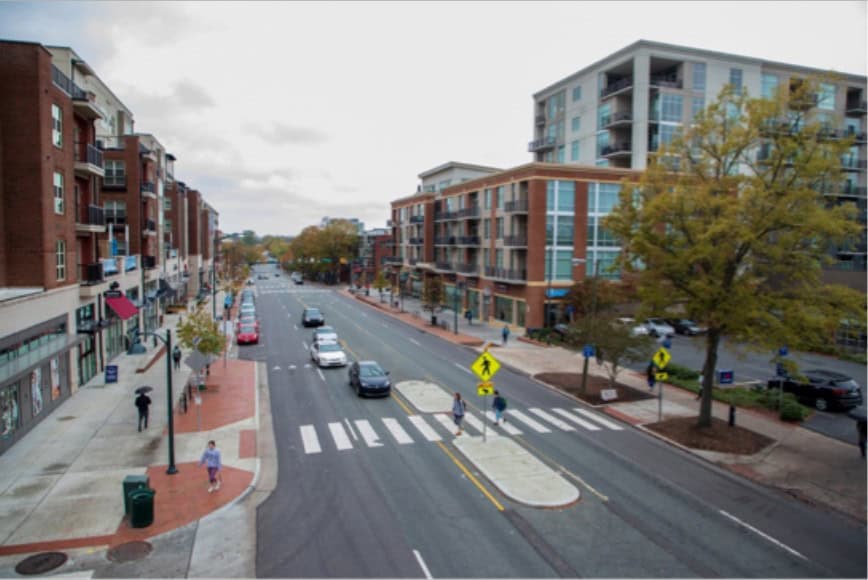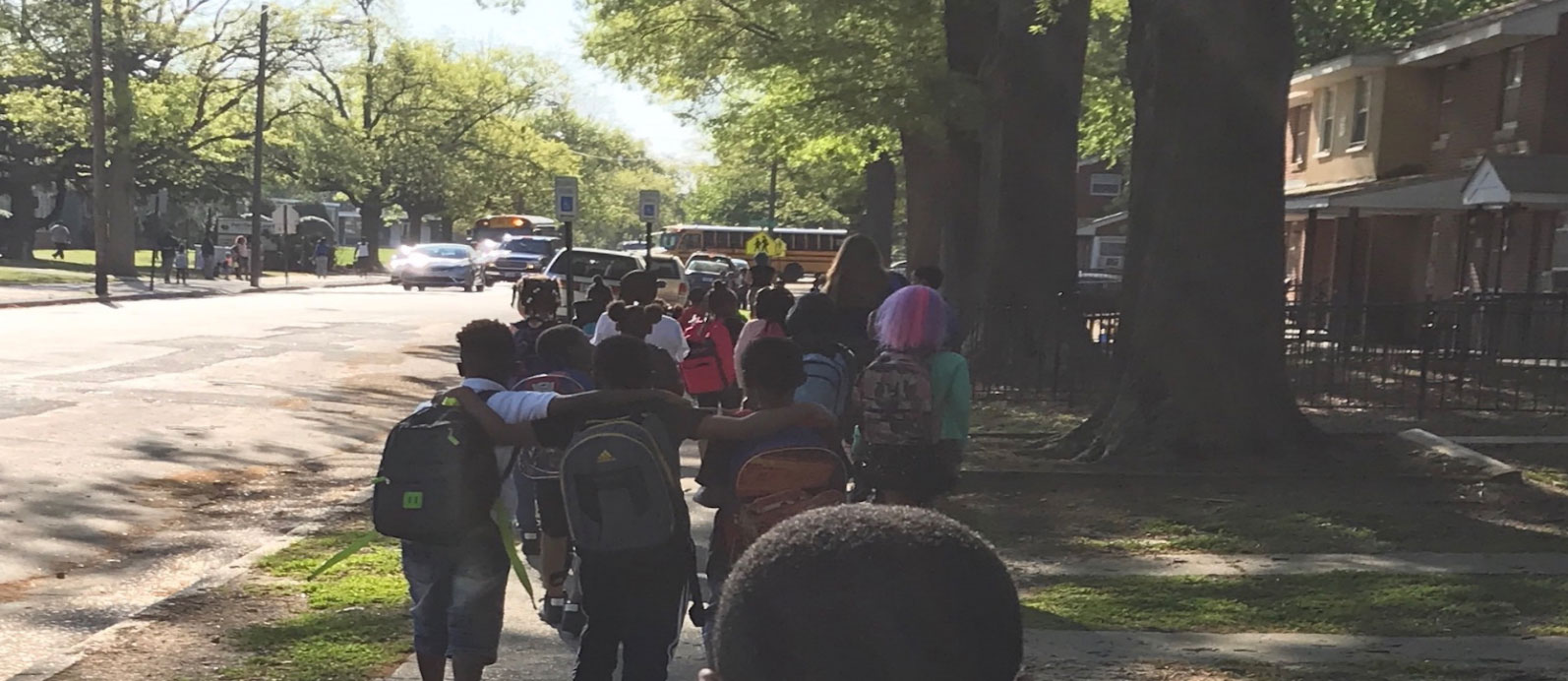Pilot Program Yields Positive Results
America Walks is deeply troubled by the sharp increase in pedestrian fatalities over the last decade. Last year, 6,227 pedestrians were killed.
This was up from almost 6,000 in 2017 and the largest number since 1990. Seniors, people of color and low-income individuals are at greatest risk – over twice as likely to be killed. In 2018, we partnered with the University of North Carolina Highway Safety Research Center (UNC HSRC) to launch the Safer Systems program. The program focused on creating the local and regional capacities to assess, plan, and prioritize effective and context-sensitive pedestrian safety countermeasures, and to increase a community’s sense of urgency for changing built environment decisions. Twelve communities participated in the year-long program, which consisted of a series of online learning modules and guided work on a pedestrian safety plan.
America Walks is excited about the work being done in these communities to improve safety for all vulnerable road users. Below is a sampling of their accomplishments to celebrate their success and inspire action in other communities across the US.
Chapel Hill, North Carolina
The Town of Chapel Hill’s participation in the Safer Systems program was part of a larger effort to eliminate pedestrian fatalities and serious injuries. In the fall of 2018, the Chapel Hill team, led by the Transportation Division, convened a stakeholder group to provide policy, technical, and design recommendations that contribute to pedestrian safety
“The Road to Zero program and its safe systems approach gave us new ideas and new tools for assessing and treating pedestrian safety concerns in town.”
and mobility with the ultimate goal of having zero pedestrian traffic fatalities on Chapel Hill roads. The group includes representatives from a variety of agencies and organizations that work with different populations and provide diverse perspectives, such as the Orange County Department of Health, SafeKids, and the Orange County Coalition to End Homelessness.

Franklin St. in Chapel Hill, NC
They conducted public outreach at various events and used that data, as well as crash data, to inform their safety improvement and program and policy recommendations. All of their work culminated in the development of a Pedestrian Safety Action Plan. The plan will guide their work in improving pedestrian safety in the Town of Chapel Hill. The stakeholder group will continue to meet occasionally to share ideas and resources over the coming years.
When asked about their overall experience with the program, Bergen Watterson, Transportation Planning Manager at the Town of Chapel Hill and the Safer Systems team lead stated, “The Road to Zero program and its safe systems approach gave us new ideas and new tools for assessing and treating pedestrian safety concerns in town. The interagency task force and pedestrian safety action plan that we created as part of the program will be integral to continuing efforts to make Chapel Hill a place with zero pedestrian fatalities and serious injuries.”
Flint, MI
The Flint team was headed by Crim Fitness Foundation. America Walks has had the pleasure of working with representatives from Crim Fitness Foundation before as Theresa Roach was a 2018 Walking College Fellow. They kicked off their work by convening a Traffic Taming Task Force, comprised of residents from several neighborhoods, to gather input concerning local traffic and safety of vulnerable road users. The Flint team also coordinated Walk to School Day events at four schools in October 2018 and used those opportunities to discuss walkability with parents and school staff.
“Our data collections show that a large number of people, about 25% are NOT conforming to the 25mph limit making all residents and visitors unsafe.”
After consulting with Department of Public Works, the Flint team purchased a speed radar sign to install on different residential streets on a rotating basis. The sign tracks traffic volume and speed and can be used for traffic calming, as well. They are collecting preand post-implementation data. Kate Cole, a resident

A Street in Flint, MI by Michigan Municipal League
of one of the neighborhoods where the sign has been placed describes how “at 2 p.m. in the afternoon you may find children, and adults walking or biking, feeling safe because they are in their own neighborhood. But our data collections show that a large number of people, about 25% are NOT conforming to the 25 mph limit making all residents and visitors unsafe.”
The sign will be held at each location for a total of twelve weeks before being moved to a different neighborhood. As of June 2019, they have had eight neighborhoods request to be added to the sign’s rotation schedule.
Through their Road to Zero work, the Traffic Taming Task Force was able to connect with new organizations and agencies. For example, the City of Flint Planning Department began inviting the group to their public forums concerning neighborhood planning projects.
Richmond, VA
Representatives from the Richmond City Health Department participated in the Safer Systems program. Sarah Shaughnessy, Community Health Planner, led their efforts and recently wrote a blog post for America Walks describing their work, both with the program and the City’s Vision Zero Initiative. Shaughnessy also adds that “participating the Road to Zero program encouraged me to think about how to develop the health department’s role in bike and pedestrian planning and gave me the opportunity to connect with and learn from others across the country who are doing the same.”
“Participating in the Road to Zero program…gave me the opportunity to connect with and learn from others across the country…”
Last fall the Richmond team attended a Walk to School Day event at one of Richmond’s Safe Routes to School program schools and worked with Fit4Kids, their partner organization, to pass out prizes to students who arrived by active transportation. The Richmond team’s safety plan involved building a database of crash data and transportation-related health and equity metrics for in-house data and policy analysis. They worked with an intern at a local university (VCU) to compile the database, which currently exists in excel and in ArcMap and is available for future analysis. They also created a set of maps to show bicycle, pedestrian, and vehicular crashes in relation to a vulnerability index developed by the state department of health called the Health Opportunity Index. These maps will soon be published on their organization’s Culture of Health Website.

A Walking School Bus in Richmond, VA
Throughout the program, the Richmond team strengthened not only strengthened existing relationships but also built new partnerships with several organizations and agencies, including the Virginia Department of Transportation, Virginia Commonwealth University, and the City of Richmond Department of Public Works, which also employs the City’s Vision Zero Coordinator.
America Walks would like to thank the National Safety Council and Road to Zero Coalition for providing funding for the Safer Systems program.
Community profiles were co-written by Bergen Watterson, Transportation Planning Manager at the Town of Chapel Hill, Cade Surface, Program Coordinator at Crim Fitness Foundation, Kate Cole, Flint resident, and Sarah Shaughnessy, Community Health Planner at Richmond City Health Department. Many thanks to them for their time and effort.
For more information visit americawalks.org or contact us at info@americawalks.org

